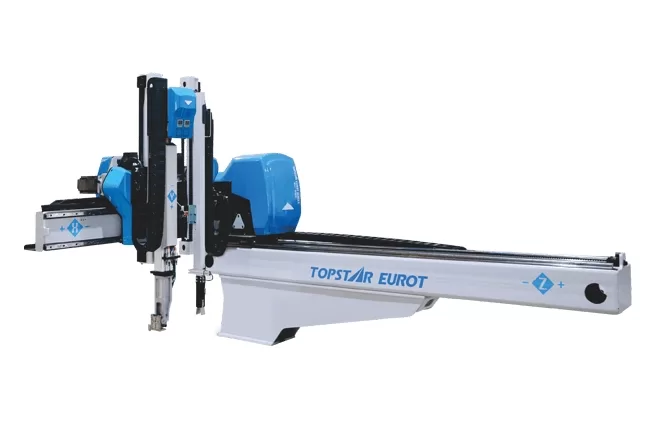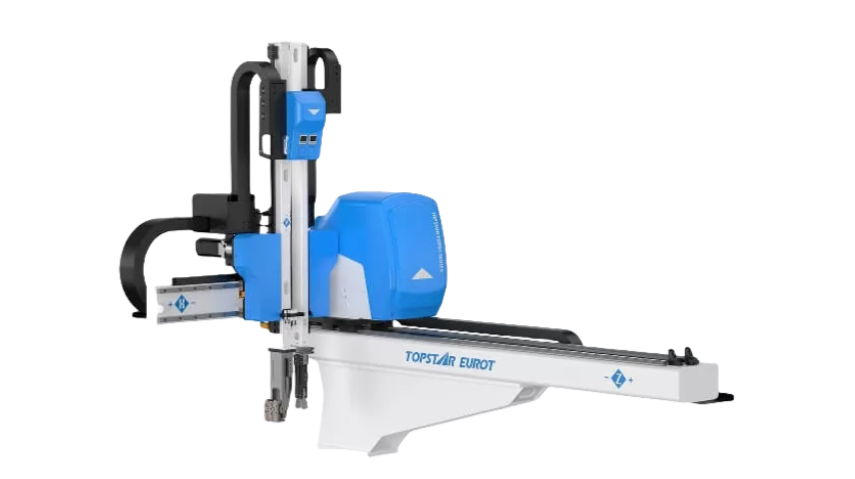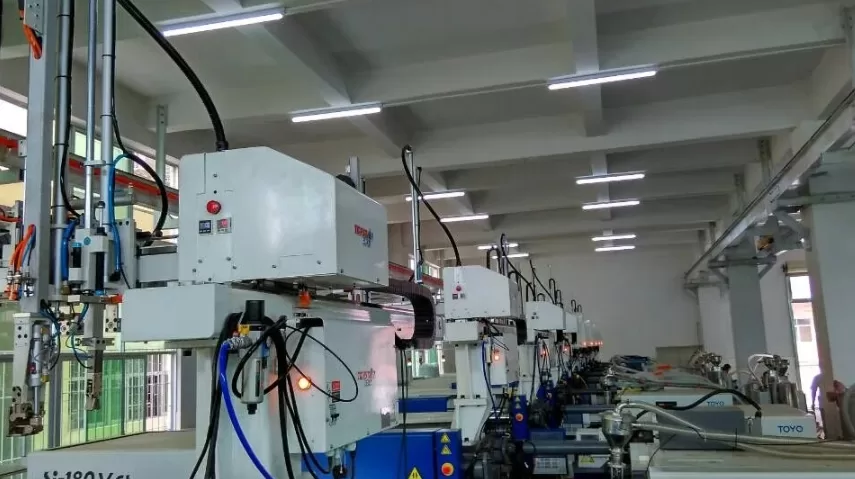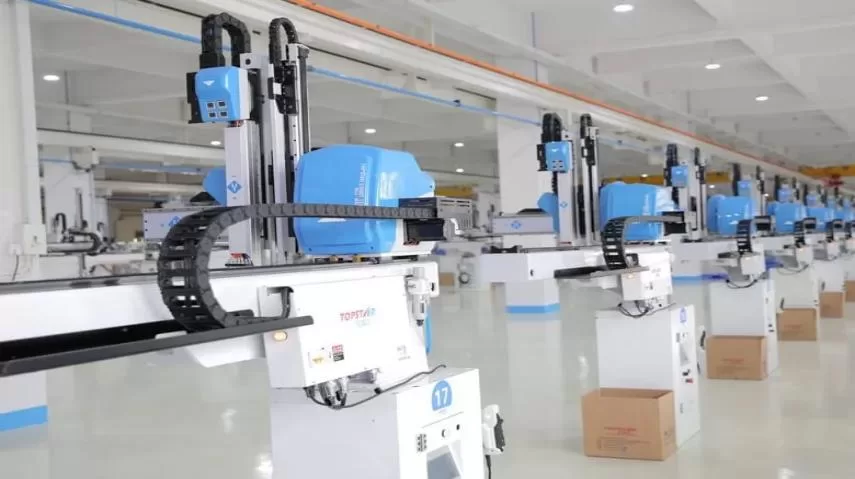What is the energy consumption of an injection molding robot?
2024/06/13 By Topstar

What is the energy consumption of an injection molding robot?
As the manufacturing industry becomes more and more automated, injection molding robot is also constantly improving the efficiency and quality of injection molding under the influence of automation. Well, many manufacturers or purchasers will pay attention to the energy consumption of these robots and whether they can reduce energy consumption. Therefore, in this guide, we will discuss the energy consumption of injection molding robots with examples.

Energy Consumption of Injection Molding Robots
Regarding the energy consumption of injection molding robots, several factors affect their energy consumption, including the type of robot, its operating parameters, and specific applications. Take the Tosda EU series injection molding robots as an example. They are suitable for injection molding machines with a 30-450T tonnage range and a maximum power consumption range of 2.1-2.8KW. Like all automated equipment, the energy consumption of injection molding robots is mainly used for movement, control systems, and auxiliary functions. The main components that generate energy consumption include servo motors, control units, and other equipment such as EOAT.
Factors affecting the energy consumption of injection molding robot
From a technical perspective, injection molding robots equipped with advanced servo motors consume less energy than robots equipped with standard electric motors because they are more efficient and precise in motion control. In terms of the type of drive system, electric drives are more energy-efficient than hydraulic drive systems. The self-developed control system used by Tosda can optimize the robot’s movement and reduce unnecessary power consumption by adapting to different load conditions.

In addition, efficient communication and synchronization between them and the injection molding machine can reduce idle time and energy waste. In addition, shortening the molding cycle time will also directly affect the robot’s energy consumption. Consuming less power occurs with shorter cycles and running times. From an operational perspective, the energy they require is proportional to the weight of the material they handle. Overloading or continuously running at maximum capacity will also lead to higher energy consumption and reduced efficiency.
Energy-saving technology used
To better reduce the electricity costs of plastic manufacturers, we have adopted energy-saving technology in injection molding robots. The lightweight and high-strength A6061 material is used on the robot’s arm, which reduces 20 structural components of the whole machine and reduces the weight by 20%, improving the overall operating performance and reducing energy consumption during operation. In addition, the standard DC bus technology saves 10% of energy and reduces the overall electricity cost by 10%. The added automatic OFF function can stop the servo motor from being powered on when in standby mode, so there will be no standby operation, thus saving 10% of electricity. In addition, our Topstar link application platform can remotely monitor the operation of the machine in real time and can be adjusted according to different situations to improve the energy efficiency of the injection molding robot.

Best practices for reducing energy consumption
Although we have adopted a series of energy-saving technologies, we still need to make certain maintenance and corresponding correct operations in daily use. Regular maintenance in daily use can ensure that all components of the injection molding robot are operating in optimal condition. Worn parts, improper lubrication, or misalignment will increase friction and resistance, resulting in higher energy consumption. Shortening the cycle time of the injection molding process can significantly reduce energy consumption. Accurate calibration of servo motors and sensors can ensure they operate within their optimal parameters. If there are misaligned components, it will put additional pressure on the system, resulting in inefficient energy use.
Future Trends
Improving energy efficiency will be a significant trend in industrial automation. In the future, AI and machine learning (ML) can be integrated into injection molding robots. AI algorithms can analyze large amounts of data to identify patterns and predict the most energy-efficient operating conditions. Machine learning models can continuously improve their predictions and suggestions based on historical performance and real-time data, making robot operations more innovative and efficient. The shift to hybrid and all-electric drive systems is another significant trend.
Energy saving in the manufacturing industry
The maximum energy consumption of injection molding robots is between 2.1-2.8KW, although other robots may be lower or higher. For manufacturers seeking to reduce costs and improve performance, significant energy savings and improved overall operational efficiency can be achieved by selecting energy-saving models and adopting best practices.
TRENDING POSTS
- What factors can cause delays in the injection molding process of plastic molding machine? 2024/06/13
- Exhibition Review| Topstar participates in InterPlas Thailand 2024 2024/06/13
- Star Case | Topstar helps Santong upgrade its intelligent plant 2024/06/13
- Topstar Special | National Science and Technology Workers Day 2024/06/13
HOT TOPIC
- 3 in 1 Compact Dehumidifying Dryer
- 5-axis CNC machine
- accuracy
- Air Chillers
- all electric injection molding machine
- All-electric injection molding machines
- and overall production quality. Therefore
- AP-RubberPlas
- automated injection molding machine
- Automation changed engineering
- automation of injection molding robots
- auxiliary machine
- Bench Injection Molding Machine
- Cabinet dryer manufacturers
- Cabinet dryers
- chiller
- CNC Drilling Machine
- CNC Drilling Machines
- cnc engraving machine manufacturer
- cnc laser cutting machine manufacturer
- CNC machine
- CNC Machine Center
- CNC Machine for Sale
- CNC Machine Manufacturing
- CNC Machine Tool
- CNC machine tool product
- CNC Machining Center
- CNC wood carving machine
- Cooling system
- Cross-Walking Single Axis Servo Cylinder Robot
- Cross-Walking Single-Axis Servo Cylinder Robot
- Cross-Walking Three-Axis/Five-Axis Servo Driven Robot
- cross-walking three-axis/five-axis servo-driven robot
- Dehumidifier Dryer
- Dehumidifying Dryer
- delta parallel robot
- Desktop Injection Molding Machine
- Desktop injection molding machines
- Desktop Molding Machine
- desktop plastic injection machine
- Desktop Plastic Injection Molding Machine
- direct clamp injection molding machine
- Direct clamp injection molding machines
- Dosing & mixing system
- Drilling Centers
- Drying and dehumidification system
- drying and dehumidifying equipment
- Drying and Dehumidifying System
- drying system
- effective and efficient. Cabinet dryers are also used in other industries where large quantities of material need to be dried
- efficient injection molding machine
- elbow hydraulic injection molding machines
- electric injection molding machine
- electric injection molding machines
- etc. Among injection molding robots
- exhibition
- features of CNC machine
- Feeding And Conveying System
- Five Axis Machine Center
- Fully automatic injection molding machine
- Gathering Topstar
- giant injection molding machine
- GMU-600 5-Axis Machining Center
- Granulating & Recycling System
- Heavy duty injection molding machine
- Honeycomb rotor dehumidifier
- horizontal injection molding machine
- Horizontal Injection Molding Machines
- Horizontal Injection Moulding Machine
- Horizontal Mixer manufacturer
- How The CNC Machine Works
- hybrid injection molding machine
- hydraulic injection molding machine
- Hydraulic Injection Molding Machines
- in this article
- Industrial robot
- Industrial Robot Chinese brand
- industrial robot parts
- industrial robot supplier
- Industrial robots
- Industry Chain
- Injection Manipulator
- injection mold machines
- Injection molding
- Injection molding automation
- Injection Molding Automation Solution
- injection molding dryer
- Injection molding equipment
- injection molding hopper dryer
- Injection molding machine
- injection molding machine brand
- Injection Molding Machine Factory
- Injection Molding Machine Manufacture
- Injection molding machine manufacturer
- injection molding machine manufacturers
- Injection molding machine procurement
- injection molding machine robotic arm
- injection molding machine with a robot
- Injection molding machines
- injection molding material dehumidifying
- injection molding plant
- Injection Molding Robot
- injection molding robot arm
- Injection molding robot automation
- Injection molding robotic arm
- injection molding robots
- Injection Moulding Robots
- Injection Robot
- Injection robot arm
- Injection robot manufacturer
- Injection robot wholesale
- injection robots
- intelligent injection molding machines
- Introducing Injection Robot
- It is the best choice for drying large quantities of material at once. Cabinetmakers use these machines because they are fast
- large injection molding machine
- Learn what industrial automation and robotics is
- low speed sound-proof granulator
- machine plastic molding
- make sure to add some! Improvements (2) Keyphrase in introduction: Your keyphrase or its synonyms appear in the first paragraph of the copy
- manipulator machine
- manufacturing
- micro injection molding machine
- middle speed granulator
- Mini CNC machine manufacturers.
- Mold Temperature Control System
- mold temperature controller
- molding material Dehumidifying System
- mould temperature controller
- mould temperature controllers
- New electric injection molding machine
- nitrogen dryer manufacturer
- nitrogen dryer system manufacturer
- Oil type mold temperature controller
- open day
- Outbound links: No outbound links appear in this page. Add some! Images: No images appear on this page. Add some! Internal links: No internal links appear in this page
- PET Preform injection molding
- phone case maker machine
- phone case making machine
- plastic bottle making machine
- plastic bottle manufacturing
- plastic bucket making machine
- plastic bucket manufacturing
- Plastic chair making machine
- plastic forming equipment
- plastic hopper dryer
- plastic injection machine
- plastic injection machines
- plastic injection molding
- Plastic injection molding equipment
- Plastic injection molding machine
- Plastic Injection Molding Machines
- plastic injection robot
- Plastic Molding machine
- Plastic Molding Machines
- plastic molding press
- plastic phone case making machine
- plastic-molding machine
- powerful granulator
- Powerful Type Sound-Proof Granulator
- production of plastic seats
- Robot injection molding
- robot injection molding machine
- robot manufacturing companies
- Robotic arm for injection molding machine
- robotic injection molding machines
- robotics in injection molding
- SCARA robot
- SCARA robots
- Service-oriented manufacturing
- Servo Cylinder Robot
- servo driven robot
- Servo Driven Robots
- servo injection robots
- Servo-Driven Robot
- Setup of injection machine
- Silicone Injection Molding Machine
- six-axis industrial robot
- Stainless Hopper Dryer
- Stainless Hopper Dryers
- star club
- swing arm robot
- the choice between servo-driven robots and hydraulic robots will have a certain impact on efficiency
- the most popular injection molding machine
- the type of injection molding robot
- toggle clamp injection molding machine
- Toggle Hydraulic Injection Molding Machines
- toggle injection molding machine
- Top 10 brands of injection robots
- Topstar
- Topstar Engineering
- Topstar Industrial Robots
- Topstar injection molding intelligent
- Topstar Scara Robots
- Useful Injection molding machine
- Vertical machining centers
- volumetric type blender
- water chiller
- water chillers
- water distributor
- Water Type MoldTemperature Controller
- We often face choices when performing injection molding. We will choose the type of injection molding machine
- wholesale of injection molding machines
- x carve CNC
